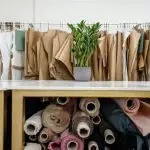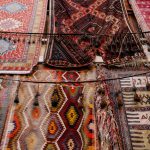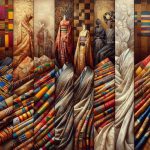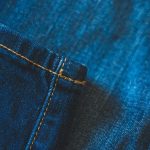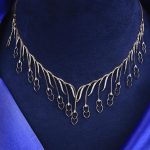If you’ve ever wondered about the allure of silk brocade fabric, you’re in the right place.
In this article, we’ll delve into the rich history, unique characteristics, and diverse patterns of this luxurious fabric.
You’ll learn about the intricate production process, the cultural significance behind silk brocade, and how to properly care for it.
Whether you’re seeking to incorporate silk brocade into your wardrobe or home decor, this comprehensive guide will help you make informed choices.
So, let’s dive into the world of silk brocade fabric together.
Table of Contents
History of Silk Brocade Fabric
The history of silk brocade fabric dates back to ancient civilizations, where it was highly prized for its intricate patterns and luxurious feel. Silk brocade fabric holds great symbolism and religious significance in many cultures.
In ancient China, brocade was associated with royalty and was used to create elaborate garments for the emperor and his court. The intricate patterns on the fabric represented different aspects of nature, such as dragons, flowers, and clouds, which held cultural significance and were believed to bring good fortune.
In addition to its symbolism, silk brocade fabric also played a significant role in cultural traditions. In India, brocade is known as ‘zari’ and is an integral part of traditional attire, especially during weddings and festivals. The shimmering gold and silver threads woven into the fabric symbolize prosperity and wealth. In Japan, brocade fabric called ‘nishiki’ is used to create beautiful kimonos and obis, showcasing the country’s rich cultural heritage.
Throughout history, silk brocade fabric has remained an important textile, embodying the craftsmanship and artistic traditions of different civilizations. Its intricate patterns, luxurious feel, and cultural significance make it a timeless fabric that continues to be admired and cherished today.
Characteristics of Silk Brocade Fabric
When it comes to discussing the characteristics of silk brocade fabric, two key points that stand out are the intricate weaving techniques used and its luxurious and elegant appearance.
The weaving techniques employed in creating silk brocade are highly intricate, resulting in a fabric that is known for its exquisite detailing and intricate patterns.
Additionally, silk brocade fabric is renowned for its luxurious and elegant appearance, making it a popular choice for high-end fashion and home decor.
Intricate Weaving Techniques
Silk brocade fabric is known for its intricate weaving techniques. The art of brocade weaving requires great skill and precision, passed down through generations of artisans.
Here are some key aspects of the weaving techniques used in creating silk brocade fabric:
-
Warp and weft: Brocade is woven using a combination of vertical and horizontal threads. The vertical threads, known as the warp, are held under tension on a loom, while the horizontal threads, called the weft, are interlaced with the warp to create the intricate patterns.
-
Supplementary weft: Brocade often incorporates supplementary weft threads to create motifs and designs. These additional threads are woven into the fabric at specific intervals, adding texture and depth to the overall pattern.
-
Jacquard looms: Traditional brocade weaving is often done on jacquard looms, which allow for intricate designs and patterns to be programmed into the loom. This technology revolutionized the production of brocade, making it faster and more efficient while still maintaining the craftsmanship and attention to detail.
The weaving techniques used in silk brocade fabric highlight the rich tradition of craftsmanship and the dedication of artisans in creating these exquisite textiles.
Luxurious and Elegant Appearance
Woven with intricate patterns and designs, silk brocade fabric has a luxurious and elegant appearance.
When it comes to care and maintenance, it is important to handle silk brocade with care. To maintain its beauty, avoid exposing it to direct sunlight for extended periods as it can cause fading.
When cleaning, it is recommended to dry clean silk brocade to prevent damage.
When buying silk brocade, consider the weight and quality of the fabric. A heavier silk brocade is more durable and suitable for upholstery, while a lighter weight brocade is ideal for clothing and accessories. Look for reputable sellers and check for any imperfections or inconsistencies in the fabric.
With proper care and purchasing considerations, silk brocade can add a touch of luxury to any setting.
Types of Silk Brocade Patterns
Take a look at the various types of patterns found in silk brocade fabric. Silk brocade is known for its intricate designs and rich texture, making it a popular choice for luxurious garments and home decor.
Here are some of the most popular brocade patterns and traditional designs you can find:
-
Floral motifs: Floral patterns are a common feature in silk brocade fabric. These designs often include intricate flowers, leaves, and vines, creating a delicate and elegant look.
-
Geometric patterns: Geometric designs in silk brocade can range from simple shapes like squares and circles to more complex patterns like diamonds and chevrons. These patterns add a modern touch to the fabric.
-
Paisley designs: Paisley patterns are a classic choice in silk brocade. These teardrop-shaped motifs originated in Persia and are known for their intricate detailing and ornate appearance.
In addition to these popular brocade patterns, traditional brocade designs often feature motifs inspired by nature, such as birds, animals, and landscapes. These designs showcase the craftsmanship and artistry of the brocade weavers, adding a touch of tradition and heritage to the fabric.
Whether you prefer a timeless floral pattern or a bold geometric design, silk brocade offers a wide range of choices to suit your style and preferences.
Production Process of Silk Brocade Fabric
The production process of silk brocade involves weaving intricate designs using specialized looms. Silk brocade fabric production techniques have evolved over centuries, with origins dating back to ancient China. The history of silk brocade is intertwined with the development of the silk industry itself.
Silk brocade is made from the finest silk threads, which are carefully selected for their luster and strength. The threads are then dyed using natural or synthetic dyes to achieve vibrant colors. The weaving process begins by setting up the warp and weft threads on the loom. The warp threads are stretched vertically, while the weft threads are woven horizontally.
Skilled artisans use a shuttle to pass the weft threads through the warp threads, creating the intricate patterns that define brocade fabric. These patterns can range from floral motifs to geometric designs. The process requires precision and patience, as even the slightest mistake can ruin the entire piece.
Over time, silk brocade production techniques have been refined and adapted to different cultures and regions. Today, modern technology has also influenced the production process, allowing for faster and more efficient weaving. However, the traditional methods of silk brocade production are still cherished and practiced by artisans around the world, preserving the rich history and cultural significance of this luxurious fabric.
Cultural Significance of Silk Brocade Fabric
Silk brocade fabric has a rich cultural significance that can be explored through its historical origins and development, symbolism and religious associations, as well as its contemporary uses and adaptations.
Understanding the historical origins and development of silk brocade fabric allows you to appreciate its evolution and the cultural contexts it emerged from.
Additionally, exploring the symbolism and religious associations of silk brocade fabric provides insight into its deeper meaning and the values it represents in different cultures and traditions.
Historical Origins and Development
During the Ming Dynasty, silk brocade fabric experienced a significant rise in popularity among the Chinese nobility. This luxurious and intricately woven fabric became a symbol of wealth and status, influencing the fashion choices of the elite. Its popularity spread beyond China, as it became a sought-after commodity along the global trade routes.
Silk brocade fabric became a staple in the wardrobes of the Chinese nobility, who used it to create elaborate garments and accessories. The intricate patterns and vibrant colors of brocade fabric made it a favorite among fashion-conscious individuals, who sought to display their wealth and taste.
The demand for silk brocade fabric spurred the growth of trade routes, as merchants from different regions sought to acquire this valuable commodity.
Silk brocade fabric’s influence on fashion and its role in the global trade routes during the Ming Dynasty cannot be underestimated. Its popularity among the Chinese nobility and its desirability among traders contributed to the spread of this exquisite fabric throughout the world.
Symbolism and Religious Associations
Symbolic meanings and religious connotations were attached to silk brocade, making it a cherished material for important ceremonies and rituals.
In fashion, silk brocade has long been associated with luxury and opulence. The intricate patterns and rich colors of brocade fabrics symbolize wealth, power, and prestige. In many cultures, brocade garments were reserved for royalty and nobility.
The use of silk brocade in home decor also carries symbolic significance. In traditional Chinese culture, brocade is often used to decorate auspicious items like tapestries, tablecloths, and curtains. These items are believed to bring good fortune and prosperity to the household.
The intricate motifs and vibrant colors of brocade fabrics add a touch of elegance and grandeur to any space, making them highly sought after for interior design purposes.
Contemporary Uses and Adaptations
In today’s fashion industry, designers have found innovative ways to incorporate luxurious brocade patterns into modern clothing designs. Brocade, once associated with traditional and ceremonial garments, has been reimagined to suit contemporary tastes and styles.
Here are some examples of how brocade fabric is being used in modern fashion:
-
Dresses: Designers are creating stunning brocade dresses that combine the elegance of the fabric with modern silhouettes and cuts.
-
Jackets: Brocade jackets add a touch of sophistication to any outfit, whether paired with jeans for a casual look or worn over a cocktail dress for a formal occasion.
-
Accessories: Brocade is also being used to make accessories like handbags, shoes, and even headbands, adding a luxurious touch to everyday outfits.
These contemporary adaptations and modern uses of brocade fabric showcase the versatility and enduring appeal of this timeless textile.
Care and Maintenance of Silk Brocade Fabric
To keep your silk brocade fabric in good condition, it’s important to follow the care and maintenance instructions. Silk brocade is a delicate fabric that requires special care to ensure its longevity and beauty. When it comes to storing silk brocade fabric, it’s crucial to keep it away from direct sunlight and moisture. Store it in a cool, dry place, preferably in a cotton or muslin bag to protect it from dust and dirt. Avoid hanging silk brocade garments as the weight of the fabric can cause stretching and distortion over time.
When it comes to removing stains from silk brocade fabric, it’s important to act quickly. Blot the stain gently with a clean, white cloth to remove any excess liquid. Avoid rubbing the fabric vigorously as it can cause damage. Refer to the table below for specific stain removal techniques based on the type of stain:
| Stain Type | Removal Technique |
|---|---|
| Oil-based | Sprinkle talcum powder |
| Water-based | Dab with a mixture of mild detergent and water |
| Wine | Blot with white vinegar and water solution |
| Ink | Apply rubbing alcohol |
Remember to always test any stain removal method on a small, inconspicuous area of the fabric first to ensure it doesn’t cause any damage. Following these care and maintenance instructions will help you preserve the beauty and quality of your silk brocade fabric for years to come.
Applications of Silk Brocade Fabric
When wearing a garment made from this luxurious material, you’ll stand out with its intricate designs and elegant texture. Silk brocade fabric has been used for centuries in various traditional applications, but it has also found a place in modern fashion and interior design.
Here are some traditional uses and modern applications of silk brocade fabric:
-
Traditional uses:
-
Clothing: Silk brocade fabric has been used to create stunning garments such as sarees, qipaos, and kimono robes. Its rich colors and detailed patterns make it a popular choice for special occasions and cultural ceremonies.
-
Home decor: Silk brocade fabric is often used to make luxurious curtains, tablecloths, and cushion covers. Its lustrous appearance adds a touch of opulence to any room.
-
Modern applications:
-
Fashion: Designers are incorporating silk brocade fabric into modern silhouettes, creating unique and eye-catching pieces. From blazers and dresses to accessories like handbags and shoes, silk brocade adds a touch of elegance and sophistication to contemporary fashion.
-
Upholstery: Silk brocade fabric is being used to upholster furniture pieces, giving them a timeless and luxurious look. It adds a sense of grandeur to sofas, chairs, and headboards.
-
Art and crafts: Silk brocade fabric is also used in various art and craft projects. It can be used for embroidery, patchwork, and even framing as a decorative piece.
Silk brocade fabric seamlessly blends traditional charm with modern aesthetics, making it a versatile choice for both classic and contemporary design.
Buying Guide for Silk Brocade Fabric
Now that you know about the various applications of silk brocade fabric, let’s dive into the buying guide for this luxurious textile. When it comes to purchasing silk brocade fabric, there are several sourcing options available to you. You can find it in specialized fabric stores, online marketplaces, or even directly from manufacturers. Each option has its own advantages and considerations, so it’s important to choose the one that suits your needs.
To help you make an informed decision, here is a table outlining the sourcing options for silk brocade fabric and their respective price ranges:
| Sourcing Option | Price Range |
|---|---|
| Specialized Stores | $$-$$$ |
| Online Marketplaces | $-$$$ |
| Direct from Manufacturers | $$$-$$$$ |
As you can see, the price range for silk brocade fabric can vary depending on where you choose to buy it. Specialized stores often offer a wider selection and higher quality, but they can be more expensive. Online marketplaces provide a range of options at different price points, while purchasing directly from manufacturers may offer unique designs but at a higher price range.
Consider your budget and preferences when selecting your sourcing option for silk brocade fabric.
Conclusion
In conclusion, silk brocade fabric is a luxurious and versatile material. It has a rich history and cultural significance. Its intricate patterns and shimmering texture make it a popular choice for various applications, from clothing to home decor.
With proper care and maintenance, silk brocade fabric can last for generations. When buying silk brocade fabric, consider the different types of patterns and choose a reputable source. This will ensure its authenticity and quality.
So, whether you’re looking to add elegance to your wardrobe or enhance your living space, silk brocade fabric is a timeless and beautiful option.
- Close-Up on Kevlar Fabric: Texture and Structure - June 21, 2025
- Kevlar Fabric Cloak: Myth Vs Modern Tactical Use - June 21, 2025
- Kevlar Fabric for Car Linings: Thermal and Acoustic Insulation - June 21, 2025

